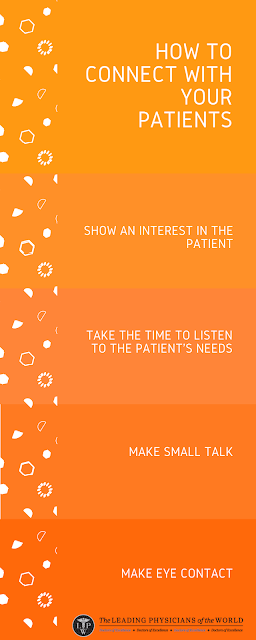Access Your Patient Communication
Effective
doctor-patient communication is a crucialstep in building a therapeutic
doctor-patient relationship, which is the heart and art of medicine. This is
important in the delivery of high-quality health care. Much patient
dissatisfaction and many complaints are due to breakdown in the doctor-patient
relationship. However, many doctors tend to overestimate their ability in
communication. Over the years, much has been published in the literature on
this important topic. Here are some tips for better doctor-patientcommunication.
1.
Attention
Because of
everything they have on their minds, physicians may not be fully attentive in
the exam room. Doctors often rely on automatic, fast thinking when interacting
with patients. But practicing mindful attention can help them slow down enough
to use deliberate, more conscious thinking when patients present signs of
something serious.
2.
Rapport
This is
imperative. Noting that the smallest details, such as physical appearance, your
level of eye contact with patients or how often you use their names in
conversation, can shape your relationships with patients. When it comes to
treatment, you want patients to feel that we’re in this together. To boost team
morale, it is recommended to give patients their full, undivided attention.
3.
Explain
Ask
patients a variety of questions that encourage them to explain more about their
health and habits outside their appointments. Questions such as, “Can you tell
me more about yourself? What is important to you? And what can I do to help
you?” can incite patients to fully engage in conversation.
4.
Curiosity
Developing
a sense of curiosity can inspire physicians to ask more questions and dig
deeper with patients, as well as foster empathy and understanding for patients’
unique needsand circumstances. It also helps doctors recognize when something is
off with a patient so they can then engage.While genetics partly
contributes to curiosity, supportive environments can also foster it, particularly
those that allow physicians to feel comfortable freely sharing their doubts and
discoveries.
5.
Practice
Practice
may not always make perfect, but it can certainly help physicians in training
get ahead of tough conversations with patients. Practice good
communication as much as possible. Ask patients for raw feedback, identify
communication roadblocks and review communication techniques with others.
6.
Collaboration
People are
far more likely to positively respond to recommendations and questions in
collaborative settings. Explain your recommendations, what you’re doing and how
you’re doing it.
7.
Presence
Listening deeply,
without judgment, interruption, or preconceptions, can be tough for physicians
who have a myriad of other things to worry about. However, a physician’s
presence can help a patient feel understood and acknowledged, and decrease
chances of miscommunication and error.
To sum up,
health professionals, whether physicians, nurses or psychologists, need to focus on and improve, if necessary, their
communication with patients; basically, learn how to unite the humanistic side
of care with the technical side; how to be professionals without losing their
humanistic identity.




Comments
Post a Comment